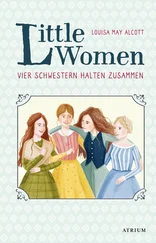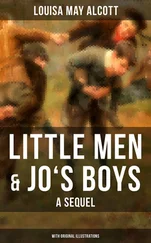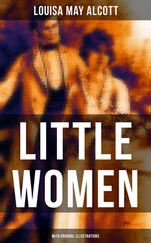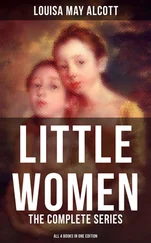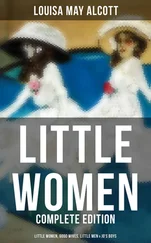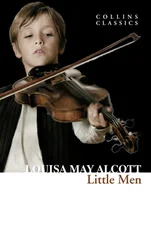Alcott hinted at the end of the first part of Little Women that a sequel might be forthcoming, “depend[ing] upon the reception given to the first act of the domestic drama” (page 229). She included this teaser even though she would later claim, upon learning that a second installment was in fact demanded of her, that she disliked the very idea of sequels. Part two of Little Women, originally titled Good Wives to portend the girls’ development as married women, begins with the eldest sister Meg’s marriage. Upon its release, Little Women, part two, was hailed as extending the March story by “loading the palate without sickishness” (by an anonymous reviewer in Commonwealth, April 24, 1869), although some might have cause to argue such an assessment. A review in the National Anti-Slavery Standard (May 1, 1869) praises the ideal families the book portrays and predicts that life will imitate art: “Thousands of young people will read [Alcott’s] story of these healthy, happy homes, and their standard of home and happiness must in many cases be raised.” The first part of this prediction has certainly come true; the second, although something to hope for in general, seems a bit much to ask even of this wholesome novel.
The sequel was written to appease Alcott’s many fans, who had been begging the author for more information about the March sisters’ future experiences—namely whom, and how well, they married. Although as a feminist Alcott personally resented the implication that her March girls’ future happiness depended upon marriage as an end in itself, she did succeed in pairing off most of her characters, although not in the neat ways her romantic readers had desired or even anticipated. Alcott’s unusual choices in this regard mystified and disappointed not only many of her contemporary nineteenth-century admirers but generations of girls to follow, who wanted the outspokenly independent, ambitious second sister, Jo, married off according to their own fancy—not to mention future generations of feminist literary critics who bemoaned Alcott’s decision to marry her off at all.
Alcott absorbed much of her reform interests from her mother, Abigail “Abba” Alcott (nee May). Marmee in Little Women is an idealized version of Abba. Whereas Marmee represses her anger for the good of her family, Abba was known for her sharp tongue and occasional inability to get along with her neighbors. Abba actively participated in various contemporary reform movements, agitating against slavery and for temperance and women’s rights, among other causes, and providing an excellent example of activism for her daughters. Even more than Marmee does, Abba Alcott worked and struggled to keep her family financially afloat; the shabby-genteel aspect of the March household stems from the Alcotts’ own straitened financial circumstances. Papa Alcott, unlike Papa March, however, was not absent on such a selfless mission as army chaplaincy. Writer and educator Bronson Alcott was associated with the original group of New England transcendental philosophers, and he tended in practice to worry more about how his family conformed to his social theories than about its livelihood.
The transcendentalism Bronson Alcott espoused was an extremely influential quasi-religious American philosophical movement that flourished in the 1830s and ’40s, most neatly summed up in Ralph Waldo Emerson’s 1836 essay Nature. As a behavioral program, transcendentalism promoted living simply, in intellectual fellowship with other like-minded thinkers and in close contact with nature, and keeping one’s body pure by avoiding alcohol, tobacco, coffee, and often, as in the case of the Alcott family, meat. As an explanatory counterpart to these lifestyle recommendations, transcendentalism’s more mystical aspects emphasized human beings’ metaphysical, intuitive spiritual core, which, in turn, evidenced mankind’s inherent personal divinity. The reverence for nature, manual labor, and self-reliance took its most notable form in Henry David Thoreau’s famous Walden Pond experiment in self-sufficiency (1845-1847). Emerson and Thoreau, friends of Bronson’s (Emerson had provided funds toward the Alcott family’s support), were two of young Louisa’s romantic crushes; some scholars have suggested Emerson as a partial model for Professor Friedrich Bhaer in Little Women. Bronson Alcott raised his daughters according to his own transcendentalist-influenced educational beliefs, encouraging stringent self-analysis from them starting at an early age, through written assessments of their behavior and development that they would produce about themselves for his perusal.
Bronson Alcott seemed to have absolved himself of nearly all financial responsibility toward his wife and children; this would have been scandalous or unforgivable at the time in most social circles, except that he styled himself as a genius—a philosopher, not a worker. Yet a family cannot live on social and educational theories alone. At one point, around the time of his ill-fated utopian communal-living project, Fruitlands (1843), Bronson seriously considered formally abandoning his wife and young children; his abstract intellectual nature led him to raise the issue with them as a matter for family debate. Facets of Bronson Alcott do appear in Father March: His favorite place is his study, and he loves his books and discussing philosophy. But a reader who knows that Bronson Alcott’s own family skills left much to be desired will find even more poignant Father March’s gentle strength and paternal perfection, as well as the confidence his daughters have in his emotional support and devotion to his family.
The eldest March sister, Meg, is based on Alcott’s oldest sister, Anna. Alcott uses her own dismay at the rupture of the family household brought about by Anna’s wedding to parallel Jo’s (and Meg’s) resistance to Meg’s marriage in Little Women. The prototype for shy Beth March was the third Alcott sister, Elizabeth (“Lizzie”), who, similar to Beth, had contracted scarlet fever after nursing a neighbor in 1856. Lizzie never fully recovered; doctors suggested various physical and mental sources, including hysteria, for her continued frailty. She slowly wasted away over a period of two years, eventually refusing even to eat. Alcott’s youngest sister, Abba May, served as the model for the petulant, spoiled, and beautiful Amy March, an artist like her real-life counterpart. May’s somewhat naive published illustrations for the first edition of Little Women unfortunately met with widespread critical disapproval (an early reviewer called the engravings “indifferently executed” and “betray[ing] . . . a want of anatomical knowledge”). However, she later studied painting in Europe (a trip financed through Louisa’s earnings from writing), lived in the Montmartre neighborhood of Paris near the experimental Impressionist painters of the day, and became acquainted with American Impressionist artist Mary Cassatt. May’s skills improved, and her artwork ultimately was accepted into Paris salon galleries in 1877 and 1879. Alcott claimed to have based Theodore “Laurie” Laurence, Jo’s best friend and neighbor, on two of her own admirers: her friend Alfred Whitman and Polish revolutionary Ladislas Wisniewski, who escorted Alcott around Paris during her 1865 European travels.
Louisa May Alcott based Jo on herself. Consequently Jo is the most fully realized, complex character and, not surprisingly, the one most beloved by Alcott’s readers across generations and most inspirational for these readers’ own fantasies and ambitions. The character shares the author’s November birth month, strong concerns about women’s claims to independence and artistic expression, and the desire to be a writer and to broaden her experience through travel far from her provincial New England home. The titles of Jo’s sensational stories are identical to some of Alcott’s own early efforts. Louisa and Jo share the title of their first published story, “The Rival Painters,” for example; Louisa’s version appeared in print in 1852. Even the cylindrical pillow Jo uses as a silent marker for her approachability in part two of the novel—if Jo stands it on end next to her on the sofa, it means she’s in a good mood; lying flat, the cushion signifies the opposite and serves notice that her family shouldn’t disturb her—echoes Alcott’s own “mood pillow,” which remains on display at Orchard House, a former Alcott family residence in Concord, Massachusetts, that is now a museum.
Читать дальше
Конец ознакомительного отрывка
Купить книгу





